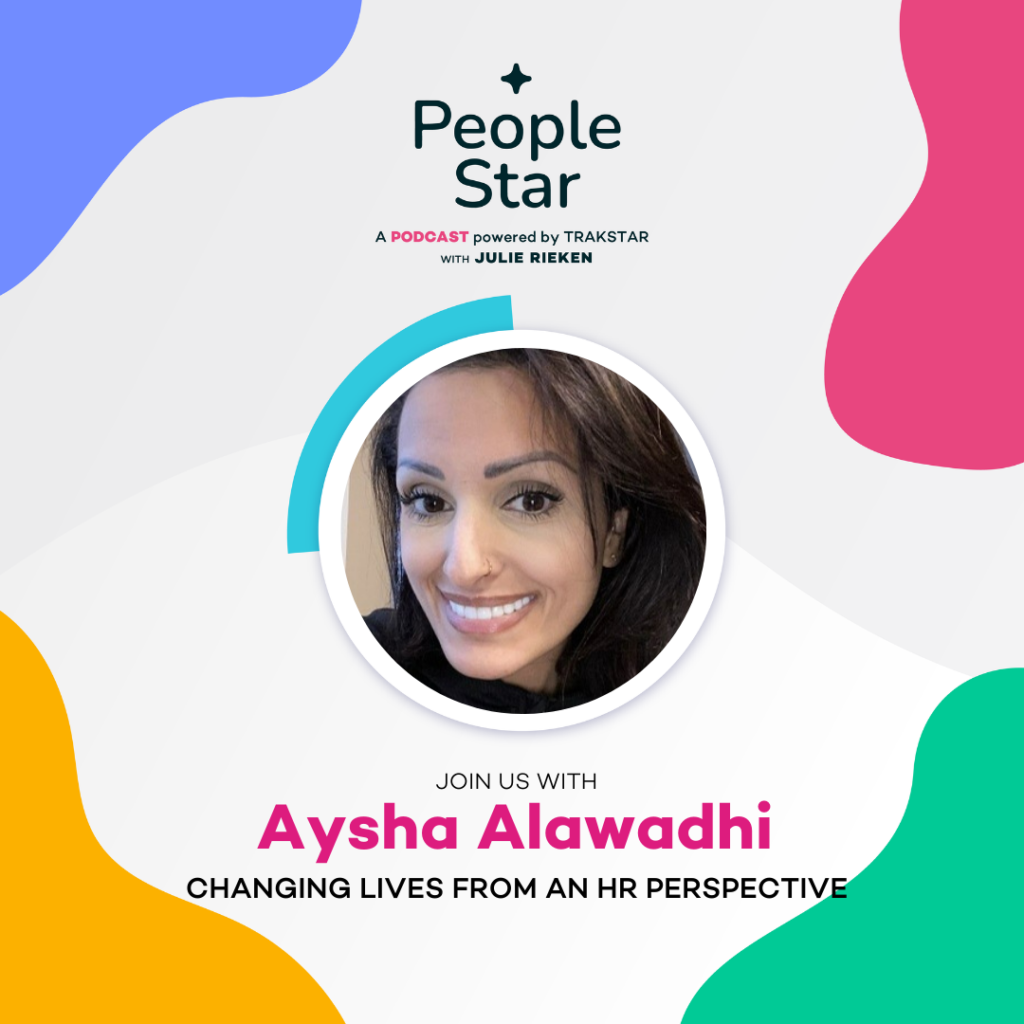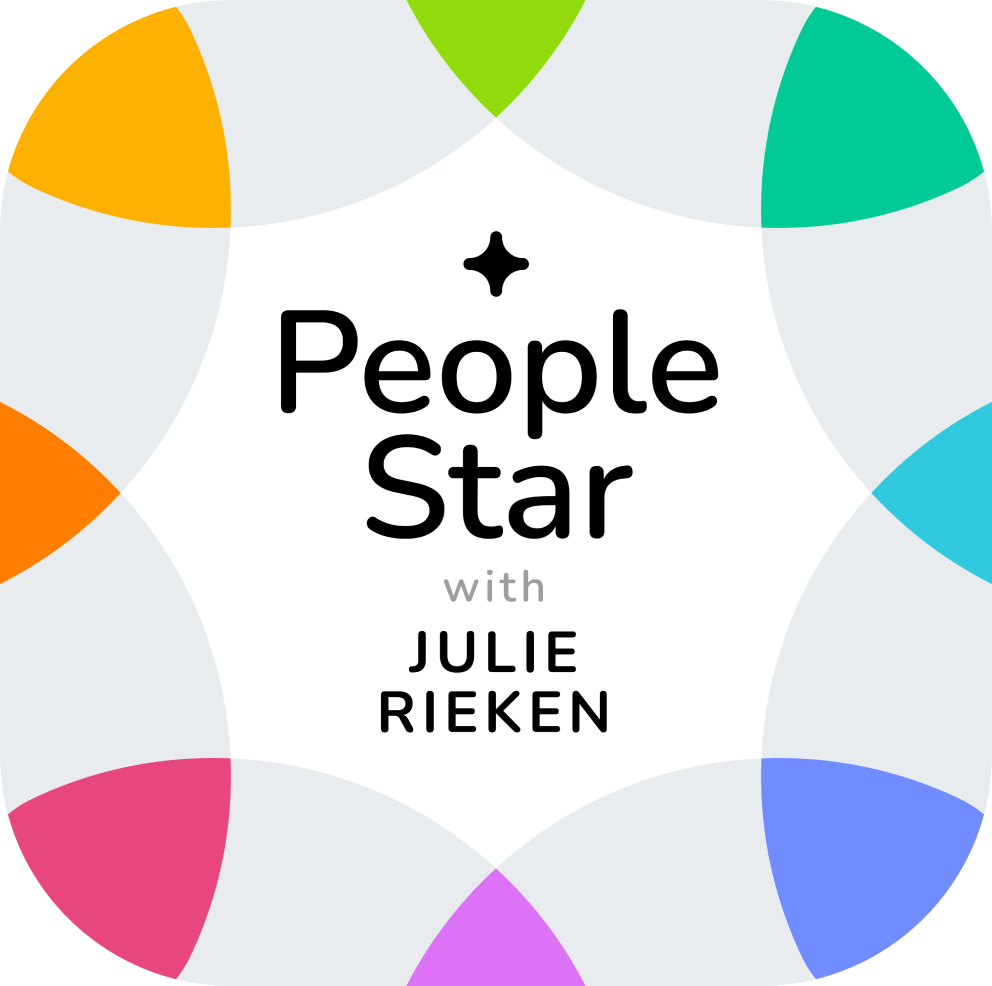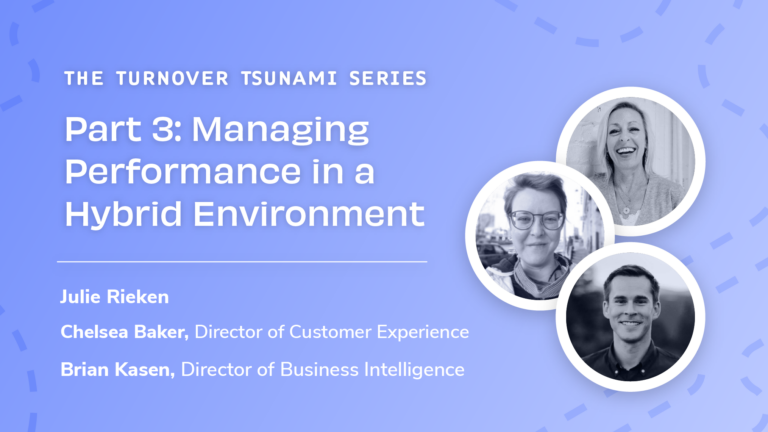PeopleStar_Aysha Alawadhi: this mp3 audio file was automatically transcribed by Sonix with the best speech-to-text algorithms. This transcript may contain errors.
PeopleStar Podcast Intro:
Welcome to the PeopleStar Podcast. We deliver leadership perspectives from industry experts on their people, architecture, routines, and culture as they solve HRs newest challenges. And now your host, Julie Rieken.
Julie Rieken:
Hello PeopleStar Podcast listeners! I'm excited today, this is Julie Rieken, host of the podcast. I've got Aysha Alawadhi with me today. Aysha has phenomenal credentials in HR, and I'm really excited for today's conversation. She's got her MSc in Human Resources from New York University, a GHPR, of course, from HRCI. Those of us in HR are very familiar with that distinctive credential. Diversity and inclusion for HR from Cornell, Employment Law, also from Cornell and a bunch of other … Basically, she's an expert. So I shall welcome, we are really excited to talk with you today!
Aysha Alawadhi:
Thanks, Julie. I'm excited to chat with you as well.
Julie Rieken:
Cool. So we've got two threads today and I want to, I want to just kick them off. Number one, Aysha, you love HR And I want to know why. And following that, we're going to talk about HR tech and analytics, and demystify some of the things that are happening in that space. So let's just kick it off with you have, for those of you, for the listeners, you can't see the big smile on Aysha's face, but I can, and she loves HR, and you're excited about this? Tell me more.
Aysha Alawadhi:
Yeah, you know, thank you. I actually absolutely love what I do. Like, if I won the lottery, I would not stop doing what I'm doing. And it all kind of happened when I, I was very, very lucky. I joined an organization that was a startup, but underneath an umbrella of a very big organization. And my then CEO, now forever mentor, sometimes unwilling, he really showed me what it was to be a people leader. He came from being a GM of HR, and he then became the CEO of this company. And I saw this man single-handedly create a culture of respect and a culture where people really believe that they could be the best no matter what their position was in the organization, whether they were people, managers, or vice presidents, or call center agents, everybody felt respected, everybody felt cared for. And being part of that team, you know, I would have everyday conversations with people, and they would tell me how coming to work was the best part of their day, and it made them better parents and better partners and better community members. And I was like, wow, this is powerful. And so ever since then, I realized that, you know, that's, I'm not going to grow up to be a Gandhi in my lifetime, but this is how I can really give back doing work that is meaningful and sends people in a positive direction, not just as, it's not just a paycheck. It's like we care about you as a person and I have that ability to change your life really.
Julie Rieken:
Love that. We sometimes say that people are happier and healthier when they know their work matters, and it sounds like you not only believe that, but find that this is a space you can make a difference in the world. That's that's really meaningful.
Aysha Alawadhi:
Yeah. You know, I never, I don't think I understood that when I was in college. I never really understood that work could be something that you drew meaning from. I thought it was something that you did to make a paycheck, and then that was it. And that was what I really believed until I met my, my CEO and I saw that. And he would make a difference in people's lives daily. And I remember there were conversations where I would be talking to someone, and they were like, you know, I'm going through a really hard time, personally, I'm going through a divorce, I went through whatever. And I just love coming to work because it's such a great environment, it makes me feel better as a person, and that just it stays with me, and it's something that I try to do every single day.
Julie Rieken:
That's really inspiring. And I think we all aspire to create workplaces like that, and that maybe is an interesting bridge for what we're going to talk about, which is even slightly different than that. We're talking about the humanity right now and how you love contributing to that human element of joy coming to work. And we want to talk about HR tech and analytics, numbers. So now we're going to talk about people, we're going to bridge that into a number conversation. And when you and I first started talking about this, you said you're not a numbers person, and I know I'm not, I'm a visual person, and I don't do public math, that's not a thing. And yet we're in the HR space, so let's talk a little bit about HR analytics and what you have learned, and how you think about numbers and data and analytics in the HR space as it relates to people.
Aysha Alawadhi:
Yeah, I very much, I will, I start off by saying, you know, I'm not a data scientist, not by any stretch of the imagination, but what I am is someone who really cares about my people, and I really want the best for them, and I want the best being what they need, not what I think they need. And I think what ended up happening was, I was in, you know, working with various clients, I just kept seeing these consultants come in and tell us what quote-unquote best practices were. You know, these were clients that were, for example, in the Middle East or in Europe. And then these best practices would come from a client in the US where culturally it's different, where everything is different. And then it was just getting frustrating because it wasn't working. And for me, I'm a fixer and I like to see stuff that works and I'm like, okay, the way I kind of spit my first analytics arm was one of the clients I was consulting with, and I'm just like, guys, we need to start listening to our people, you know? And other than having 5,000 individual interviews, there has to be a better way to do this. And then it kind of started to click slowly that we, actually as HR gather a lot of data. And if we work with our business, our business is gathered a lot of data, and a lot of this data is pertaining to our people, their performance, their attendance, their feedback, their, all of these various elements that we are already collating. And so I took a step back, and I was like, how do I, first of all, get all this, make sure it's cleaned up, and then make, make it make sense to me and tell me a story? And that's kind of where my journey in HR analytics kind of fell into place. And then I started to understand the different types of data that you can pull, and initially it was just like, what's on hand? And we started pulling attendance, and we started pulling stuff from the engagement surveys and stuff from our sales. And then it was, first it was a big mess that was scary. I didn't know what to look at, what not to look at, but as I just started pulling all of it and started studying it and started to understand how it connected to my people and their performance and why they did what they did, we would work backwards based off of what we were seeing and we would try to see is there patterns that we're noticing? And it was really trial and error. And as we started to see and come up with some hypothesis and test them out and then put solutions in place for that. We … Start to see a positive uptick in performance and engagement and all of that stuff. And we started to figure out, oh wow, what we're doing is actually working, and that's kind of where my journey in analytics started. And whenever I work with clients now, the first thing I say is you have this information somewhere. You don't need to go out and spend millions of dollars on some kind of tech, or you don't need to build a massive team, like start where you're at. Let's look at the data that you have, right? And then go from there, because your needs as a, as an organization is very different than the next organization's needs. And you really have to be comfortable with customizing it and not focusing on what the quote-unquote, best practices, according to a big consulting firm.
Julie Rieken:
Super important. There's two things, two threads I'd like to pull out of there. You said, what do you look at? What do you look at? You said performance, attendance. What do you look at? What do you choose? There's a lot of things we could look at. What do you think are some critical pieces, 1, 2, 3 pieces, or 4? What do you think?
Aysha Alawadhi:
Well, I think it's first important to figure out what you're trying to solve, right? Are you an organization that is trying to, so data analytics or people analytics are for purpose. They're not just to have the numbers, just to have them and send out sexy reports. What are we trying to achieve here? Do we have a problem with attracting talent? Do we have a problem with performance? Do we have a problem with attrition? What is the problem that we are trying to solve? First, as an organization, you need to figure that out, and then once you do, you need to start looking at what is, what are the data points that I'm already collecting, right? We are collecting tons. So look at that to see, okay, let's say you have a problem, for example, with, I don't know, retention, maybe we start to look at things like your engagement scores, maybe start to look at things like your performance, start to look at things like what are the, who are the people in the organization that are performing well? Is there a certain talent profile that I can maybe create based on the ones who are performing well versus the ones that are leading? So if you start to think about what you're trying to solve and then pull the the information that could potentially be relevant, you could actually start creating a data map that that is telling you a story, but then you could also progress to becoming very predictive. I mean, we went from creating this jumble mess of here's all the people information that we've got. Then it's like, okay, what's starting to make sense? We start to weed it out a little bit, and then we started to become a little bit predictive, like, oh, well, what we're noticing here is that people who are, for example, successful in sales tend to have a specific profile, and then people who are successful in audit tend to have a particular profile. So now all of a sudden you're able to inform your talent acquisition as to what you have seen is working. You know, another example is we were able to look at our attrition data to say, well, you know, what we're noticing after studying it is that there is a particular kind of person who leaves us, oh, wait a minute, we're also seeing that if you step back before they leave, they're red flags that are being pointed out. So now we can create an early warning system and be able to tackle those issues before they become issues. So again, it just really depends on what your what your why is and what you're trying to solve. And if you don't have a problem, a general problem, that you're like, I need to solve this. I would say, look at what are the data points that you're collecting as an organization? Start studying them and figure out what the story is that they're telling you.
Julie Rieken:
I love that. What stories does the data tell? I want to go back to something you said even, even as we were initiating this piece about what do I look at? You mentioned something about different places culturally have different kinds of things that that are meaningful to them. And I think this is something a lot of organizations out there face. This group of people in this location has a different set of needs or wants or priorities from a cultural perspective than a group in another place. Can you just talk a little bit about that? Because I think I'm coming from, we're a US-based company and most of our customers are, but we all have wings in different, in different places. And I don't think we know how to think about that. I think that's, it's a, I don't know if you want to call it an oversight or not knowing what to do, but how do you think about employee things across locations where there may be cultural differences? How do you think about it?
Aysha Alawadhi:
Yeah, yeah. I think, look, there's there's different types of culture as well. Is it ethnic culture or is it … culture or is it just the culture of the organization? Because you can be an organization that is in the US and you have two different branches, one in San Francisco and one in New Hampshire, and you have totally different corporate cultures, even though people's backgrounds are very homogenous. So you have to figure out what my culture in this company is and the way that you do that is you start to get to know your people, start to like, you know, put your pulse on or put your finger on the pulse of what's actually going on. And it's important that organizations also understand the kind of culture that they want to have, right? Articulate that, explain it to everybody, and then map out what that looks like in terms of your behavioral competencies and your skills. And once you have that as a baseline in this company, this is how we function, it becomes a lot easier to mitigate the differences in background and ethnicity and all of that other stuff, because now we all understand what the common language is that we have to speak and how we have to live it. So that's really important. And if you don't do that, it doesn't mean that you're not going to have a culture. It means that a culture is going to form, that's very unintentional, it may be toxic.
Julie Rieken:
That's really true. Defining what it should look like is a really important, what do we want it to look like? It sounds like maybe your, the mentor that you talked about initially had a very strong perspective on what that should look like and was able to, was able to share that throughout the organization.
Aysha Alawadhi:
And what works for one organization doesn't necessarily have to work for the other. So maybe your organization is one that is focused on a culture of collaboration. So then define that. What does that mean in the way that I behave? What does that mean in the way that I'm rewarded? What does that mean in the way that I have to show up at work? And then maybe you have an organization that is extremely focused on high performance. Again, define it. What does it mean in my behavior, in the way that I'm rewarded and all of that other stuff? And then that will make sure that you are able to get people to behave in a consistent way. And then also what will do is make sure that you're attracting and keeping the people that fit that culture because not everybody's going to fit the culture that you want and that's okay. But if it's clear, then you have the right people and you're going to keep the right people and you're going to get to where you need to go. But if you don't have that defined, then don't expect to, to deliver on your strategy because you're just going to be dealing with a mess.
Julie Rieken:
Aysha, this has been a wonderful conversation that has been too short and I've really enjoyed it. I think we could talk for a long time about this and I've learned so much just in the short time we were together. And I want to thank you for your time and for being a guest today.
Aysha Alawadhi:
Thank you.
PeopleStar Podcast Outro:
Thanks for listening to the PeopleStar Podcast. For the show notes, transcript, resources, and more ways to get a seat at the table, visit us at TrakStar.com/Podcast.
Sonix has many features that you’d love including automated subtitles, share transcripts, transcribe multiple languages, automated translation, and easily transcribe your Zoom meetings. Try Sonix for free today.




